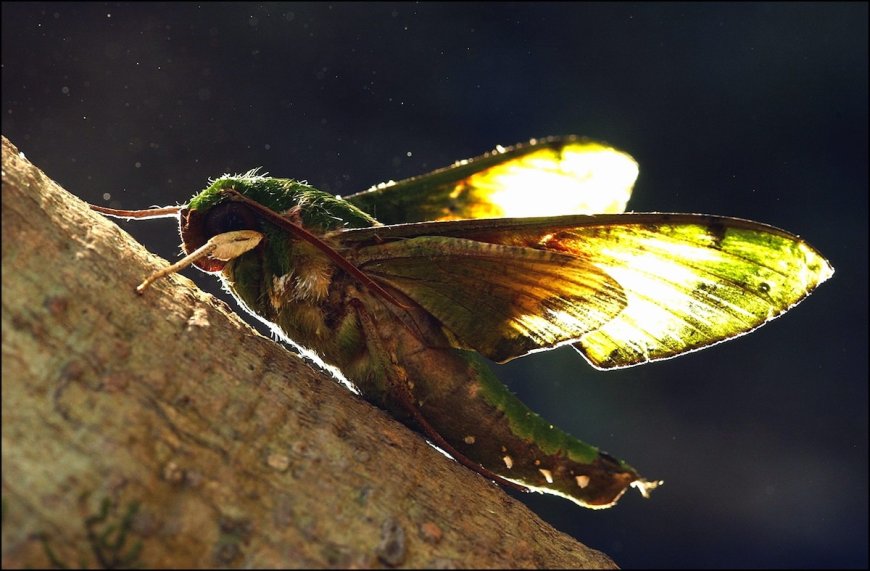Pollination ‘Magic’ Happens at Night Too, First-of-Its-Kind Study Finds
Pollinators are essential for the reproduction of most plant species, including many major food crops, as well as for the maintenance of healthy ecosystems. A new research review by scientists at Lund University in Sweden has found that — in 90 percent of cases studied — nocturnal pollinators like moths are just as important as […] The post Pollination ‘Magic’ Happens at Night Too, First-of-Its-Kind Study Finds appeared first on EcoWatch.

Pollinators are essential for the reproduction of most plant species, including many major food crops, as well as for the maintenance of healthy ecosystems.
A new research review by scientists at Lund University in Sweden has found that — in 90 percent of cases studied — nocturnal pollinators like moths are just as important as bees and other daytime pollinators.
“The daily transition between day and night, known as the diel cycle, is characterised by significant shifts in environmental conditions and biological activity, both of which can affect crucial ecosystem functions like pollination,” the authors of the findings wrote. “Our synthesis revealed an overall lack of difference in pollination between day and night; many plant species (90% of studied spp.) exhibit similar pollination success across the diel cycle.”
For more than six decades, scientists have been trying to determine whether the pollination of plants happens mostly during daylight hours or at night, without any clear conclusion being reached, a press release from Lund University said.

The research into diel pollination differences examined different pollination outcomes between night, day, open, and closed pollination treatments (A), progressed over time (B), occurred across a range of daylengths (C), temperature conditions, and elevations (D). The time series (B) shows the cumulative (line) and annual (bars) number of publications. Each study’s daylength (C, hours) was computed using each study’s location and median date. Daily temperature range and elevation (D) were extracted based on study location (see Methods). Ecology Letters (2024). DOI: 10.1111/ele.70036
Most people are aware of the importance of bees, butterflies and birds for plant reproduction and agriculture, but less attention has been given to pollinators who are active at night, like bats, nocturnal butterflies and moths. And these equally important pollinators don’t just get less recognition — they are also less protected than their daytime counterparts.
The interest of Liam Kendall and Charlie Nicholson, researchers from Lund University, in nocturnal pollinators was piqued when they ran across studies exploring individual plant species that are pollinated in the daytime versus at night. They suspected that previous research might have overlooked nocturnal pollinators.
Kendall and Nicholson put together data from 135 studies around the world and found that, of the 139 species of plants examined, 90 percent had similar reproductive success whether they were pollinated at night or during the day.
“We were definitely surprised by the number of plant species where it didn’t matter. We found this really fascinating because it’s easy to assume that a specific plant needs a specific pollinator. The analysis actually showed almost the opposite — there’s much more flexibility. A different pollinator than expected can contribute enough for a plant species to reproduce,” Kendall said.
The results of the first-of-its-kind global meta-analysis bring up questions of human biases in science. Kendall hypothesized that many researchers have likely had a fixed idea of how pollination for certain plants should occur. Kendall also speculated that most people being active during daylight hours could lead to them overlooking what happens while they’re sleeping.
“We have this idea that all the magic happens during the day, because that’s when we’re active, and that’s when we see bees and butterflies fluttering around flowers,” Kendall said.
Kendall believes daytime pollinators being seen as beautiful is a factor as well.
“Bees are such a big part of our cultural identity. We learn that they’re important. And they’re fluffy and cute to look at. While moths — I mean, they have their prettier cousins, the butterflies, which we love, but moths are gray and dusty, and they eat your clothes. How could they possibly do anything positive?” Kendall added.
Given human activity’s pressure on biodiversity, the researchers said their study calls attention to the importance of considering daytime and nocturnal pollinators in conservation and agriculture.
For example, Kendall said the life cycle of a moth is entirely different from that of a bee, so their ecological needs are different.
“The analysis shows that we need to change the way we think about how environments can support pollinators and biodiversity,” Kendall said.
And if pollination at night is really important, it becomes critical to avoid light pollution — excessive or badly placed lighting that disturbs the natural environment.
“Actions are often taken to protect daytime pollinators, such as spraying pesticides at night. There’s an oversight there — sure, you’re protecting the daytime insects, but you’re also, theoretically, harming the nocturnal pollinators. This means we could be doing much more, but we haven’t thought enough about it so far, and more research is needed,” Kendall said.
The study, “Pollination Across the Diel Cycle: A Global Meta-Analysis,” was published in the journal Ecology Letters.
The post Pollination ‘Magic’ Happens at Night Too, First-of-Its-Kind Study Finds appeared first on EcoWatch.



















































